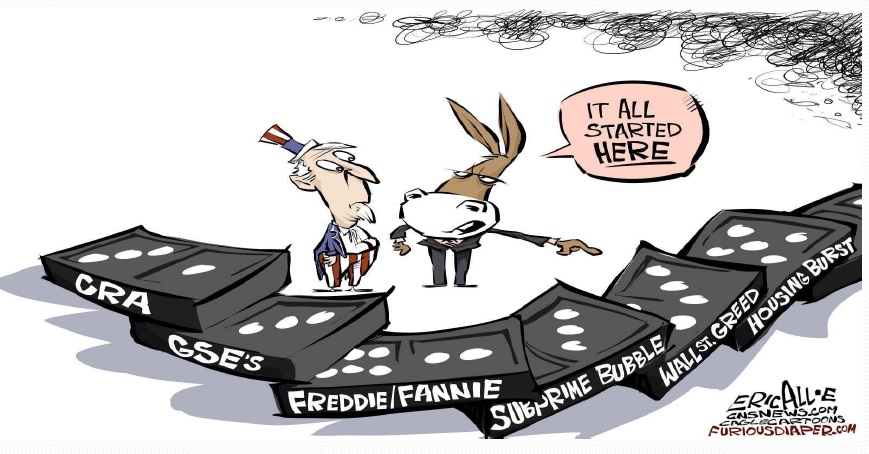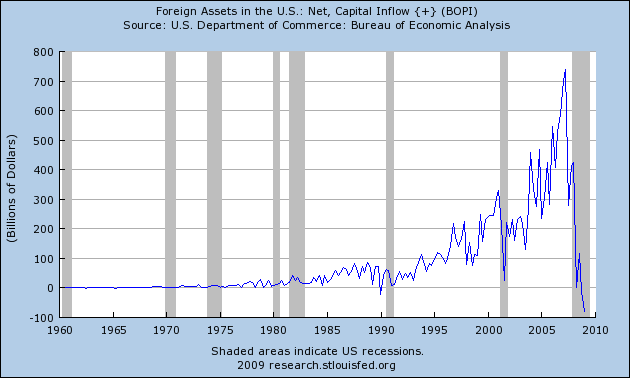UPDATE: The Detroit News has a piece today on the Obama agenda and the possibility that a Depression could result. They make points similar to those I have been worried about.
The concerns of the majority of American citizens with out-of-control spending do not impress the left. They advise Obama and Congress to ignore those pesky voters.
MAJORITY STILL MISGUIDED ON ECONOMIC PRIORITIES…. The polling has been remarkably consistent on this all year. And it irks me every time.
Americans are more concerned with lowering the massive budget deficit than boosting the ailing economy, according to a new national poll.
Fifty-six percent of people questioned in a CNBC survey released Friday morning say President Barack Obama and Congress should worry more about keeping the budget deficit down even if that means delaying the economic recovery. That’s 23 points higher than the 33 percent who feel boosting the economy should be the top priority, even if that means larger deficits now and in the future.
This continues to be hopelessly backwards. Given the precarious state of the economy and widespread concerns about unemployment, common sense suggests concerns over the deficit should wane. But all of the recent polling suggests a majority of Americans really do care more about deficit reduction than growing the economy and creating jobs.
The left is still convinced of the efficacy of the command economy in spite of the collapse of the Soviet Union and the evolution of Communist China into a semi-capitalist economy.
They are convinced, in spite of all evidence to the contrary, that Roosevelt saved the country from the Depression by spending. The concept that the New Deal was the cause of the Depression is totally alien.
This is not just a repudiation of Amity Schlaes book, The Forgotten Man, but also new scholarship from serious academics.
Two UCLA economists say they have figured out why the Great Depression dragged on for almost 15 years, and they blame a suspect previously thought to be beyond reproach: President Franklin D. Roosevelt.
After scrutinizing Roosevelt’s record for four years, Harold L. Cole and Lee E. Ohanian conclude in a new study that New Deal policies signed into law 71 years ago thwarted economic recovery for seven long years.
“Why the Great Depression lasted so long has always been a great mystery, and because we never really knew the reason, we have always worried whether we would have another 10- to 15-year economic slump,” said Ohanian, vice chair of UCLA’s Department of Economics. “We found that a relapse isn’t likely unless lawmakers gum up a recovery with ill-conceived stimulus policies.”
In an article in the August issue of the Journal of Political Economy, Ohanian and Cole blame specific anti-competition and pro-labor measures that Roosevelt promoted and signed into law June 16, 1933.
“President Roosevelt believed that excessive competition was responsible for the Depression by reducing prices and wages, and by extension reducing employment and demand for goods and services,” said Cole, also a UCLA professor of economics. “So he came up with a recovery package that would be unimaginable today, allowing businesses in every industry to collude without the threat of antitrust prosecution and workers to demand salaries about 25 percent above where they ought to have been, given market forces. The economy was poised for a beautiful recovery, but that recovery was stalled by these misguided policies.”
“Today” was 2004 when the Congress was still in the hands of Republicans. There are many things that Congress, and the Bush Administration, did wrong but no one would have predicted that the exact same policies these scholars condemned would again be enacted only five years later.
Another example that is never discussed is the 1920 recession. The fact that this recession was as severe as the 1929 crash is almost never discussed.
The end of World War I caused the federal budget to decline from $18.5 billion in 1919 to $6.4 billion in 1920. Although this decline in budgetary stimulus required an increase in investment and spending by the private sector, Congress raised taxes on individuals and corporations, while the Federal Reserve Bank restricted credit by raising its discount rate for member banks from 4.75 percent to 7 percent by 1920. Unemployment rose from 4.0 percent in 1919 to 11.9 percent in 1921, but subsided to 7.6 percent in 1922 and 3.2 percent in 1923. The recession contributed to the failure or merger of 2,024 banks (6.5 percent of the total) by 1925.The economy’s industrial and commercial sectors revived after 1921, but agriculture did not. Farm prices dropped sharply as world output rose after the war, and US farmers responded by overproduction, which created surpluses that drove commodity prices progressively downward through the 1920s. Farm income dropped from 15 percent of national output in 1920 to 9 percent in 1928; 454,866 owner-managed farms disappeared in the 1920s, and the farm population decreased by 3,000,000. The agricultural depression led to the closure of 5,400 rural banks during the decade.
The agricultural depression is usually emphasized in any discussion of the 1920s. My own family were farmers but left the farm during that decade. The fact is that national prosperity was also contributing as agricultural productivity soared with mechanization of farming and new technology with fertilizers and the systems of crop rotation.
What is almost never discussed is why the 1920 recession ended so quickly. Thousands of banks failed yet, by 1923 employment was back to normal even though a million men had been demobilized as the war ended in 1918. What happened ?
There is a good deal of speculation in the economic literature but the conclusions vary. What is clear, though, is that President Harding and VP Coolidge did NOT do what Hoover and Roosevelt did after the 1929 crash.
The 1920-21 deflation contains another striking feature. Not only was it sharp, it was large relative to the accompanying decline in real product. The ratio of the percentage decline in the GNP deflator for 1920-21 to the percentage decline in real GNP is 2.6 using the Department of Commerce figures, 3.7 using the Balke and Gordon data, and 6.3 using the Romer data. By contrast, during 1929-30, the first year of the Great Depression, the GNP deflator declined by 2.7 percent and real GNP by 9.4 percent, for a ratio of 0.3. The ratios of the percentage decline in GNP prices to the percentage decline in real GNP for 1930-31, 1931-32, 1932-33, and 1937-38, the other Great Depression years in which real GNP declined, were 1.0, 0.9, 1.2, and 0.3, respectively, all well below the 1920-21 figures.
The 1920 recession was more severe than the 1929 crash in its effect on prices and wages.
The contraction then became severe. By the year’s end, industrial production had fallen 25.6 percent below its January 1920 peak and bottomed out at 32.6 percent below its January 1920 level in July 1921, the general business trough. Wholesale prices were 42.9 percent below their May 1920 peak by July 1921. Industrial production had fallen by 32.6 percent in eighteen months, wholesale prices by 42.9 percent in fourteen months. The deflation eliminated more than 70 percent of the rise in wholesale prices associated with World War I.
In one year, 70% of the inflation of WWI was eliminated !
Friedman and Schwartz [1963, 205-39] attribute the severe phase of the 1920-21 recession and its attending deflation to monetary restraint. Monetary policy was expansive throughout World War I, including the period of U.S. neutrality. Policy remained expansive during most of 1919, even though by summer an inflationary boom was underway. The Federal Reserve was pegging interest rates at a low level using its loan discount rate in order to accommodate the Treasury’s funding of the war debt. The Fed also had an interest in protecting commercial bank portfolios, which contained substantial quantities of war bonds and loans secured by war bonds.
Monetary policy began to shift in December 1919, then changed markedly in January 1920.
What happened in 1920 ? There was an election.
The Federal Reserve Bank of New York’s discount rate, which had been pegged at 4 percent since April 1919, was raised to 4.75 percent in December 1919, to 6 percent in January 1920, and to 7 percent in June 1920. Similar discount rate increases were made at the other Federal Reserve Banks.
This was still Wilson’s Progressive administration but Wilson was disabled by a stroke. Colonel House and Mrs Wilson were basically running the administration. The 1918 election returned control of the Senate to Republicans, who picked up seven seats. The war ended with the Armistice a week later. The Republican Senate is often blamed for the failure to ratify the League of Nations although Wilson’s failure to compromise on some issues is also to blame. Its influence on monetary policy is usually ignored.
There is much speculation about why the recession was so severe but little about why it ended so quickly.
Austrian School economists and historians argue that the 1921 recession was a necessary market correction, required to engineer the massive realignments required of private business and industry following the end of the War. Historian Thomas Woods argues that President Harding’s laissez-faire economic policies during the 1920/21 recession, combined with a coordinated aggressive policy of rapid government downsizing, had a direct influence (mostly through intentional non-influence) on the rapid and widespread private-sector recovery.[11] Woods argued that, as there existed massive distortions in private markets due to government economic influence related to World War I, an equally massive “correction” to the distortions needed to occur as quickly as possible to realign investment and consumption with the new peace-time economic environment.
That is the last paragraph of the article. It may be the most important. Harding cut government spending and let the private economy alone to recover. It did so completely in one year. Ten years later, Hoover, followed by Roosevelt, enacted progressive prescriptions and the Great Depression followed. Now, we seem to be on the same path.

